Carols in Harry Potter And The Myth Of The Christmas Rose (Part 1)
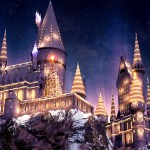
Dec 23, 2018
News, Opinion
From Harry’s first Christmas at Hogwarts, to Hermione and Harry’s poignant scene in Godric’s Hollow on Christmas Eve, the Holidays are a huge part of the Harry Potter series. As December 25th approaches, guest writer Dr Beatrice Groves (author of Literary Allusion in Harry Potter) returns with an in-depth analysis of festive themes in the Potter series, to help get us in the festive spirit:
How many Christmas carols are sung in Harry Potter?
One answer is: more than you might think. Christmas is a major feast in Harry Potter: Nancy Solon Villaluz has kindly done the number-crunching and tells us that the word alone occurs two hundred and thirty four times. But Christmas generally seems a rather secular affair. And, in truth, chocolates, crackers and Christmas trees are more in evidence at Hogwarts than any more obviously Christian celebrations. Christmas carols, however, are sung throughout the series, preparing the reader for Christmas night in Deathly Hallows where the Christian symbolism of the day finally becomes fully present.
Carols first appear in Chamber of Secrets where they form part of the Christmassy pleasures of the Great Hall in full festive splendour: ‘a dozen frost-covered Christmas trees and thick streamers of holly and mistletoe crisscrossing the ceiling… enchanted snow was falling, warm and dry, from the ceiling. Dumbledore led them in a few of his favourite carols, Hagrid booming more and more loudly with every goblet of eggnog he consumed’ (Chamber, Chap 12). Later in the series Rowling makes wizarding carols fully comic – with Sirius’s version of ‘God rest you Merry Gentlemen’ (‘God rest you Merry Hippogriffs’) and Peeves’s rude additions to ‘O Come all ye Faithful.’ But even in Phoenix the sound of carols has a redemptive potential as Sirius’s joy washes over Harry as he sits in self-imposed isolation: ‘Harry could not remember Sirius ever being in such a good mood; he was actually singing carols, apparently delighted that he was to have company over Christmas. Harry could hear his voice echoing up through the floor in the cold drawing room where he was sitting alone’ (Chap 23). The knowledge that Dumbledore, Hagrid and Sirius all know carols off by heart (even if the bewitched suits of armour are a bit hazy about the words) sets the scene for the final, fully Christian carols that waft over the snow to Harry and Hermione as they stand in Godric’s Hollow churchyard as Midnight Mass is celebrated.
The church in Godric’s Hollow is the only church in Harry Potter and although Harry and Hermione never enter it, it is at the centre of something. Its stained-glass windows glow ‘jewel bright across the square’ and the light from its ‘brilliant windows’ brighten the snow: ‘a blanket of pale blue that was flecked with dazzling red, gold and green wherever the reflections from the stained glass hit the snow’ (Deathly Hallows, Chap 16). It emanates light and its music reaches out to them. It is only when they hear ‘a carol start up inside the little church’ that Hermione realises that it is Christmas.
“The singing grew louder as they approached the church. It made Harry’s throat constrict, it reminded him so forcefully of Hogwarts, of Peeves bellowing rude versions of carols from inside suits of armour, of the Great Hall’s twelve Christmas trees, of Dumbledore wearing a bonnet he had won in a cracker, of Ron in a hand-knitted sweater …”
As in Chamber, the twelve Christmas trees are once again mentioned alongside carols, and it seems possible that the Christian significance of the number (echoing the twelve days of Christmas) is meant to be heard.
As John Granger has shown it is in this final Christmas of the series that the first Christmas – the Christmas which carols celebrate – is finally fully present in Harry Potter. Harry and Hermione, in the disguise of man and wife, and returning to the place of his birth, are suffering in the cold and excluded from the warm houses all around. But there is also a Christian marker in this scene that has not been previously noted: the wreath of Christmas roses that Hermione conjures for Harry to lay on his parents’ grave.
The Christmas rose is often overlooked in the modern celebration of Christmas, but in the nineteenth and early twentieth centuries its astonishing ability to bloom in mid-winter made it a deeply popular sacred flower. It was cultivated on a grand scale for the Christmas trade and inspired many pious Christmas tales and carols (the flower is even sometimes called ‘Christmas Carol’).
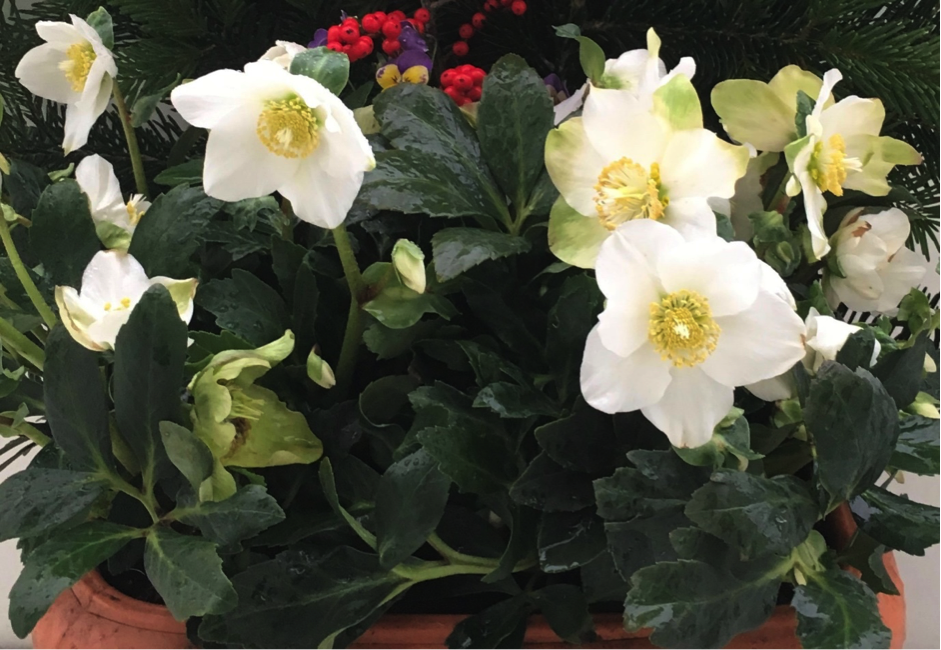
Photo: Hellebore Niger Christmas Carol
I have previously written for Leaky about the way in which Rowling uses traditional plant lore and flower symbolism and I do not think it is chance that this flower, so steeped in Christian symbolism, appears in the series on Christmas night. For it is not only that stories about this flower locate its birth as the first Christmas night but that Harry’s plight at this moment, standing weeping in the snow, resonates strongly with the myth of the Christmas rose.
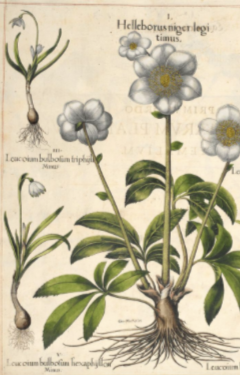
(Image: Basilius Besler, Hortus Eystettensis (Altdorf, 1613) British Library)
As Harry notes very few plants survive in mid-winter: all around him are ‘leafless and frozen’ (Deathly Hallows, Chap 16). Those that plants that do flourish at Christmas, however, have long been invested with Christian significance. The holly, for example, is known in Scandinavian countries as ‘Christ-thorn’ as well as carrying Christian imagery in the famous carol ‘The Holly and the Ivy.’ Such imagery is one reason that Harry (remember Trelawney’s prediction of his mid-winter birth?) has a holly wand: holly, as Rowling has noted on Pottermore, is a wand-wood which chooses owners engaged in ‘spiritual’ quests. Pre-eminent among these plants, however, is the Helleborus niger or Christmas rose, which is known in Germany as the Christrose. The Christmas rose’s appearance at a holy time of year, as well as its ability to flower among snow and ice, gave it an enchanted aura and tales flourished about both its magical, healing properties and its connections with the Christ child. And it is a flower that not only appears in Harry Potter in this pivotal moment in the churchyard in Deathly Hallows, but also as a symbolically appropriate Potions’ ingredient earlier in the series.
So, while you’re wondering about where it turns up in Potions (answer tomorrow!) here is the appearance of the Christmas rose in Godric’s Hollow:
“But they were not living, thought Harry: they were gone. The empty words could not disguise the fact that his parents’ mouldering remains lay beneath snow and stone, indifferent, unknowing. And tears came before he could stop them, boiling hot then instantly freezing on his face, and what was the point in wiping them off, or pretending? He let them fall, his lips pressed hard together, looking down at the thick snow… He should have brought something to give them, and he had not thought of it, and every plant in the graveyard was leafless and frozen. But Hermione raised her wand, moved it in a circle through the air and a wreath of Christmas roses blossomed before them. Harry caught it and laid it on his parents’ grave. (Deathly Hallows, Chap 16)”
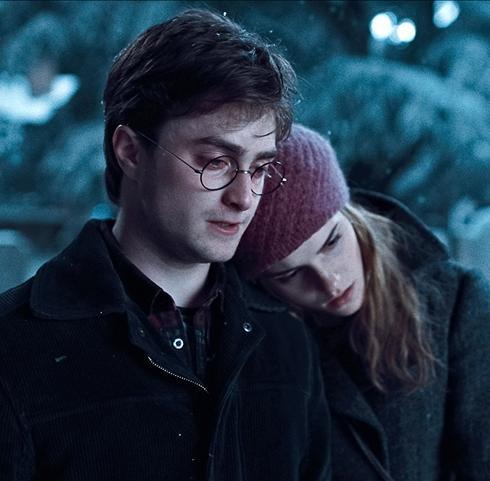
Harry’s situation and the comfort of Hermione’s friendship at this moment both strongly recall the tradition of the Christmas rose. Harry, like the children in these stories, stands weeping in the snow on Christmas night, while Hermione, like the angel in the story, perfectly understands his unspoken desire and gives him the perfect gift.
The Myth of the Christmas Rose
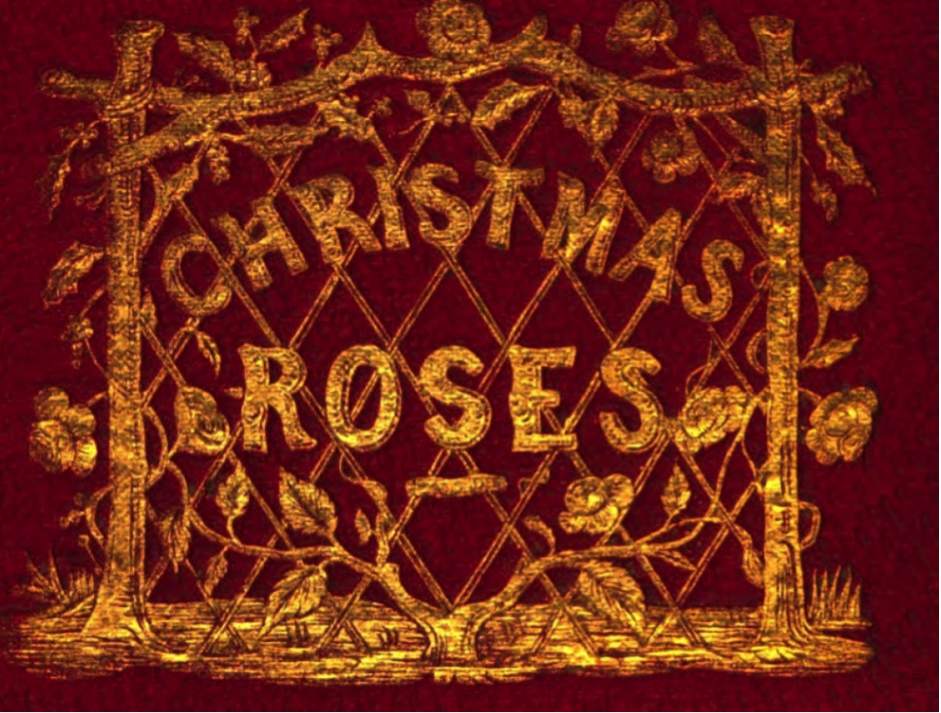
The Christmas rose features most strongly in Germanic fairy tales where it appears in two distinct – but related – traditions. In the first, the Christmas rose is given by the Christ Child on Christmas night to a weeping child in order to heal a sick relative; in the second, the flower springs from the snow when (on the first Christmas night) a child cries because they have no gift to give the baby Jesus.
The earliest English version I have been able to track down is an 1845 translation of ‘The Christmas Roses’ by Albert Ludwig Grimm (a German collector of folk and fairy tales who, slightly surprisingly, is no relation to famous Brothers’ Grimm). In this story a family is torn apart when the boy contracts a fatal illness. His sister goes to a doctor for a cure for him, but the doctor cannot help her, telling her: ‘where is the herb that can cure death?’ Marietta, weeping, returns home and (like Harry) has not realised that it is Christmas Eve until she sees a ‘bright light’ in the rose-arbour. Moving towards the light an angel gives her the Christmas rose as a gift from the Christ Child for her brother. When she gives her brother the flower its divine scent cures him. The story ends with the family growing Christmas roses for evermore: ‘in the dark days of winter, when the frost had locked up the earth, and all other flowers slept deep hidden in their buds and germs, then these lovely white blossoms appeared.’ In later version of this tale – Sepp Bauer’s Die Christrose (1920) – the search for the flower becomes more of a quest narrative, and it is the children’s father who is cured by the Christmas rose. And the children are aided on their journey by talking animals: one of whom, to my delight, is called Crookshanks.
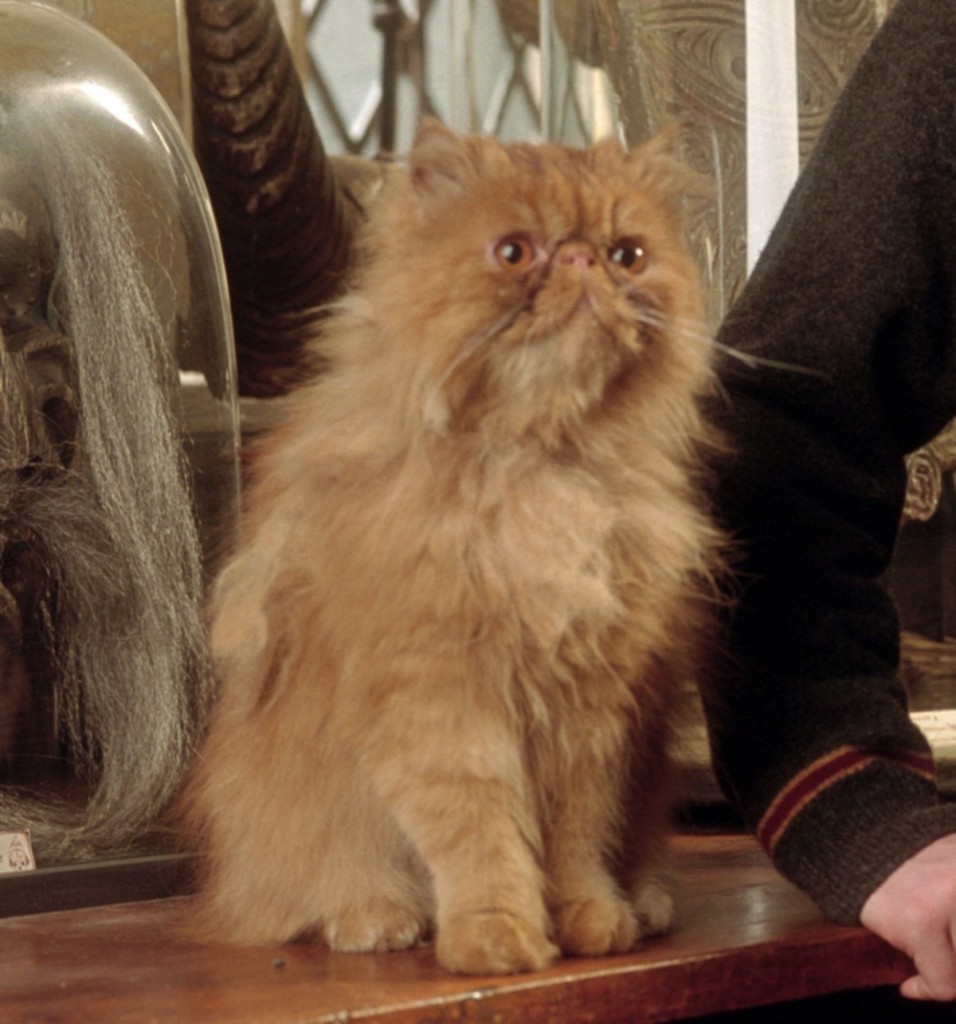
In the second version of the Christmas rose myth, however, the flower does not heal sickness, but sorrow. Florence German’s ‘Vigil of the Christmas Rose’ (1902) tells of how the devoted flower chose to fall with Eve, and leave Paradise. An angel asks the Christmas rose whether this devotion was worth it, and the flower replies that she is glad of what she has learnt, despite the suffering it has cost her: ‘for I have been close to sorrow, and to sin, and to death, and know that love is stronger than all.’ The Angel rewards her by saying that ‘when the love that shall conquer sorrow and sin and death is born into the world thou, of all flowers, shalt be the first to see it.’ And on the night that Christ is born the shepherds rush to Bethlehem:
“And behind them, sobbing in his haste, limping on a lame foot, in rags, came a little shepherd lad. His heart was of all most eager to welcome the new Master-Shepherd, but his feet were halt and lame, and his hands empty of an offering. What was that among the grass at his feet, fair and white and shining even as a pearl? Was not the earth herself providing the gift for an offering? The lilies of the field, the roses of Sharon were asleep under the stars, it was the white hellebore that was brought as a gift to the manger.” (Florence German, ‘The Vigil of the Christmas Rose’, 1902)
The Christmas rose springs magically from the ground to a child who would otherwise visit the stable empty handed. This idea is repeated in Helen K Watts’s Legend of the Christmas Rose (1931), a poem in which the shepherd’s daughter (Madelon) thinks – like Harry – that if only it were summer she could take the new born Christ child a flower:
‘But now ‘tis cold and winter’s here;
No flowers above the ground appear.
I can bring nothing.’
But her sorrow is short-lived for an angel appears and presents her with the Christmas rose to give as her gift to the new-born Christ.
It is this, latter, version of the story that was once a popular source for carols. In Frederick H. Martens ‘The Christmas Rose’ (1916) Zal ‘a little shepherd maid’ is filled with sorrow by her failure to bring a gift to the stable, but is met by an angel:
“The angel smiled. With a lily wand
He touched the earth, and the naked land
Awoke as though thrilled by Spring’s warm glows,
And white was the ground with the Christmas Rose!”
There is a clear link between these stories and carols and the appearance of the Christmas roses in Deathly Hallows. All the stories take place on Christmas night. All of them stress the cold, and many of the children, like Harry, weep in the snow before the Christmas rose comes to sooth their sorrow. In many of them the child reflects, as Harry does, on how easy it would have been to give a flower in warmer months, but now everything is frozen and bare. The children who travel to Bethlehem, just like Harry returning to his parents’ grave, have full hearts but empty hands until the magical appearance of the Christmas rose which means that they (magically) have a gift to express their love.
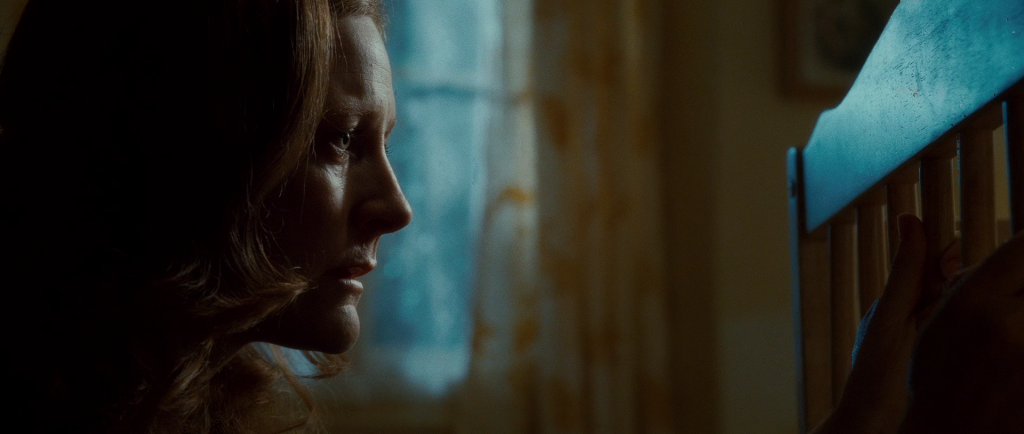
It is also noticeable for our purposes that two of these stories mention lilies (one notes that the Christmas rose blooms, though the lilies were asleep; another has them bloom from the tip of the angel’s lily wand). But in addition to the possible, though pleasing, naming links of Lily and Crookshanks, it is the underlying moral of the myth that speaks most clearly to the parallels with Harry Potter. The Christmas rose embodies the idea of love that comes as a freely given gift. The Christmas rose declares ‘I have been close to sorrow, and to sin, and to death, and know that love is stronger than all.’ Love is stronger than death in Harry Potter too. When Slughorn declares a love potion ‘probably the most dangerous and powerful potion in this room’ (Half-Blood Prince, Chap 9), he is met with scepticism from smirking Slytherins: a scepticism that points towards the central plot-point that the descendant of Salazar Slytherin likewise fails to understand this power. A power that is declared by Dumbledore, as it is declared by Christianity, to be stronger than death:
‘There is a room in the Department of Mysteries,’ interrupted Dumbledore, ‘that is kept locked at all times. It contains a force that is at once more wonderful and more terrible than death, than human intelligence, than the forces of nature. It is also, perhaps, the most mysterious of the many subjects for study that reside there. It is the power held within that room that you possess in such quantities and which Voldemort has not at all. That power took you to save Sirius tonight. That power also saved you from possession by Voldemort, because he could not bear to reside in a body so full of the force he detests. In the end, it mattered not that you could not close your mind. It was your heart that saved you.’ (Phoenix, Chap 37)
Tomorrow’s post will look at the way in which the Christmas rose underlies Christina Rossetti’s famous carol ‘In the Bleak Mid-winter’ and suggest why it the flower turns up in a Potions’ class in Phoenix.


